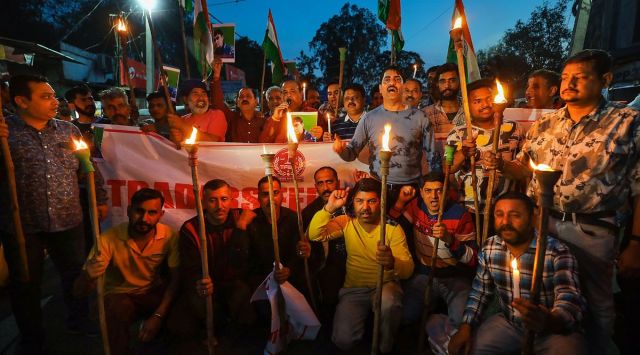
Terrorists killed a Kashmiri Pandit who was working as a bank guard, in Litter, in South Kashmir. The deceased, Sanjay Sharma, was shot at point-blank range. It appears that the security establishment of South Kashmir has been inadequate in its response towards the wanton targeted killings of Kashmiri Pandits by so-called “hybrid terrorists” for the past few months. Recently, the terrorist outfit Lashkar-e-Toiba issued an open threat to the organisers/panellists of a two-day global Kashmiri Pandit conclave in Delhi, which concluded on February 26. The LeT, under the guise of “Kashmir Freedom Fighters” brazenly accepted the killing by their men. The release stated: “Today in the wee hours, our cadre eliminated a Kashmiri Pandit namely Sanjay Sharma s/o Kashinath Sharma r/o Achan Pulwama. We have already warned many times in the recent past that any Kashmiri Pandit, Hindu or tourists from India will be eliminated.” The conclave in Delhi was successful as it could garner the support of the Indian civil society and government leaders.
The killing of Kashmiri Pandits is designed to deny their return and their right to life and liberty. This community has been living in exile, as refugees, in their own country and beyond for 33 years. The few who chose to stay back are now being targeted and even killed. A robust security apparatus has led to terrorists focussing on such “soft” targets.
Since 2019, nearly a dozen Kashmiri Pandits, including two sarpanches, have been murdered. Five local Hindus, 26 non-local labourers and truck drivers, innocent Muslims and off-duty police officials have been killed.
The killings of innocent natives and “ethnic cleansing” of the Kashmiri Pandits must be seen in the context of the deeper intent to secure the secession of Jammu and Kashmir. The crimes committed against the Kashmiri Pandits are, by any yardstick, deserving of the strongest condemnation and there can be no gainsaying the acute suffering, deprivation and rootlessness suffered by the community.
Having lost some leading members, the community is stricken with grief. But it is deeply resilient and has not been destroyed.
The LG administration has made claims about the improved security situation in J&K. Perhaps, in terms of absolute figures, this is technically correct. But Kashmiri Pandits have become targets since August 5, 2019. From 2003 till 2019, the killing and targeting of Kashmiri Pandits had largely stopped because of social and political engagement.
Using official data released annually by the police, journalists and other civil society actors examined the violence and militancy curve in Jammu and Kashmir from 2019 till the end of 2022. The analysis also cross-checked the data on civilian killings with independent documentation by rights groups, minority representative bodies and media reports. While there has been a clear drop in militant violence, the figures revealed some worrying trends. While militancy has taken a hit, it has also morphed. Take the case of what the police in Kashmir call “hybrid militancy”. Unlike in the past when young men would post their pictures with guns on social media to announce their entry into militant ranks, “hybrid militants” are part-time militants who go back to their ordinary lives as soon as they carry out an attack or kill a civilian. What further complicates the challenge is that most of the “hybrid militants” are impressionable teenagers, some underage, who have no record of militancy or cases registered against them.
Thousands of civilians have been killed in Kashmir since an armed insurgency against the Indian government began in 1989. While Kashmiri Muslims still constitute a major proportion of the civilian casualties in the last four years, there is ample evidence to suggest that other minorities and migrants, who were earlier rarely targeted by militants, have become vulnerable.
The J&K police too pay a price. While the overall number of casualties of security forces in militant attacks has come down since 2019, the proportion of police personnel losing their lives has more or less stayed the same. In the last four years, around 215 security personnel, including 60 members of the police, have been killed in the Union territory.
The extremists have sought to project the conflict in Kashmir as a religious one. Islamist militants, for instance, supposedly target Pandits because they view the community as loyal to India, by virtue of their being Hindu. This mentality can be defeated only by promoting and reviving the composite inclusive Kashmiri culture.
Kashmiris are sick of violence. The people’s participation in democratic processes, especially women and youth, can become a game-changer. They openly prefer democracy, peace and development as a way forward. In panchayat and DDC elections, Kashmiris voted in large numbers. It is now time for assembly elections.
The exiled natives of Kashmir are longing to return. The Kashmiri majority community is also waiting for Kashmiri Pandits to come back home. They too want to build a Naya Kashmir, revive inclusivity and defeat terrorism.
The writer is a senior advocate, Supreme Court of India